Footy Fix: The Cats are inevitable - and they're smarter, clutcher, quicker, and scarier than ever
"I am inevitable" - Thanos, Avengers: Endgame You know that scene at the end of a horror movie where everyone thinks the killer is…
An AFL player that gets chosen with the prized number one pick in their year’s national draft has a heavy burden to carry.
For some, like Jack Watts and Tom Boyd, the toll the pressure takes proves too much of a burden. For others, like Sam Walsh, they need just a few games to prove they’re well and truly going to live up to the billing.
With Harley Reid looming as the next player to be given the mantle of the best young player in the land, with West Coast set to use their prized pick on him after months of discussion, it’s time to look back at the history of the number one draft pick, from its humble beginnings to the enormous hype it carries today.
Here’s how we ranked all 39 number one picks to date, from the worst, all the way up to the best.
Not ranked: Aaron Cadman (GWS, 2022)
Last year’s top pick managed 12 games in his debut season and showed glimpses, but it wouldn’t be fair or objective to rank him on this list already. Young stars often take time to develop – key forwards most of all.
38. Richard Lounder (Richmond, 1987)
Sorry, Tigers fans, but any list of the worst AFL anything running from the 1980s till present day will probably feature your mob near the bottom of the list.
Lounder, a mountain of a ruckman taken from Central District in the SANFL, kicked four goals on debut for the Tigers in Round 5 of 1989. But he’d manage just three more games before being dropped, and that was where his VFL/AFL career would end.
He’d head back to South Australia at the end of the season, but remains the answer to a trivia question at Tigerland: at 116kg, he is still the heaviest player ever to play for the club.
37. Stephen Hooper (Geelong, 1990)
The draft wasn’t really taken seriously by clubs until the mid-1990s, so you can expect to see a lot of the earlier number one picks in the lower rungs of this list.
Hooper, a talented Western Australian ruckman (spotting a pattern yet?) headed east to Geelong for the 1991 season. However, knee tendonitis restricted him to just 21 matches across three years, before being delisted at 24 by the end of 1993.
He’d head back to East Perth, but couldn’t shake his knee problems, playing only a handful of games.
36. Anthony Banik (Richmond, 1989)
Another Tiger from their inglorious late-80s period, Banik, like Hooper, is one of the strangest stories in Tigers history.
Taken as a 16-year old from South Australia in the 1989 draft, he’d debut in Round 3 the next year. He’d miss just four more games across the next two seasons as he made a half-back flank his own.
Then, Banik contracted chronic fatigue syndrome, and everything changed. He’d managed just five games in 1992, and one more in 1993, as he dealt with the illness. While he’d manage five games, including the final round, in 1994, and win the club’s reserves best and fairest that year, he’d be delisted shortly after.
However, unlike Hooper, Banik’s story has a happy ending: he’d return to South Australia and dominate for West Adelaide, winning best and fairests in 1995 and 1997.
35. Alex McDonald (Hawthorn, 1988)
Unlike the other names near the low end of the list, McDonald actually had a decent run of things in the AFL, managing 107 games. However, only 46 of those came with the Hawks, who drafted him out of Ballarat for the 1989 season as reigning premiers.
He’d go on to play 61 further games at Collingwood after moving at the end of 1995, where he made a name for himself as a tagger. However, hip problems forced him to retire at 29, ending one of the more obscure careers from a number one draft pick.
34. John Hutton (Brisbane Bears, 1991)
Some fires burn so fiercely from the outset that they simply fizzle out before their time. Such was the case with Hutton, who burst onto the scene with the Bears in 1992.
A talented forward who booted 100 goals in the WAFL with Claremont in 1990 before being snaffled by the Bears, Hutton would twice bag eight-goal hauls in his debut season to win the club’s leading goalkicker award.
Bizarrely, he’d be delisted come season’s end despite all that, and his career would never recover. Stints at Sydney in 1993 and Fremantle in 1995 yielded just 18 further games (though he did manage another eight-goal haul for the Dockers against the Swans themselves); and at 29, opted to retire then and then.
33. Martin Leslie (Brisbane Bears, 1986)
A star in the SANFL with the mighty Port Adelaide outfit of the time, Leslie was drafted by the Bears at the end of 1986, but elected to stay in SA for a further two seasons. After winning a premiership with the Magpies in 1988, he’d begin a seven-year stint in Brisbane as a 26-year old; making him the oldest number one draft pick at the time of his debut.
He’d win a best and fairest in 1990, but would never reach the heights he did in his home state. Late-career injuries bit, and he’d finish with 107 games for the Bears.
32. Clive Waterhouse (Fremantle, 1995)
Unfortunately, you don’t get bonus points in our rankings for being a cult hero, otherwise Clive would be near the top of this list.
Playing 106 games and booting 178 goals, the much-maligned Waterhouse was an important figure in the Dockers’ formative years; at the time of his retirement, he was the leading goalkicker in the club’s short history. However, he seldom reached the heights expected of him when taken with pick one in the 1995 draft.
The mulleted forward’s finest hour came in the infamous ‘Demolition Derby’ of 2000, which featured some of the game’s most brutal brawls. He’d boot seven goals to inspire the Dockers’ most famous ever comeback, having trailed by 42 points early in the third quarter.
Booting 53 goals for the season and finishing high in the club’s best and fairest, it seemed like Clive had arrived. Unfortunately, it would prove his greatest hit; he’d manage only 21 further games across the next four seasons before being delisted.
31. Paddy McCartin (St Kilda, 2014)
The first post-1990s selection to appear on this list, McCartin’s AFL career at the Saints looked set to serve as a cautionary tale about just how fragile an AFL career can be.
A surprise choice with the Saints’ prized pick in 2014, McCartin was touted as the long-term replacement for champion, and another number one pick, Nick Riewoldt in the Saints’ forward line (more on him later).
But after struggling with fitness in his first season, the key forward would be dealt the first of what would become an unshakeable curse: concussion. Suffering head knocks against Collingwood, Adelaide and Gold Coast by Round 15 – the latter particularly innocuous – McCartin would prove too susceptible to concussions to get a serious chance at an AFL career.
He’d manage just five games in 2017, picking up a sixth concussion in four years in the VFL; while he’d play a career-best 11 games in 2018, his chances of being the player he was destined to become as a junior were all but dashed. Another concussion in the 2019 pre-season led to him being delisted by the Saints at season’s end, to enable him time to deal with the toll of repeated head blows.
When we originally made this list in 2021, McCartin was in the bottom four. However, a successful and even inspirational return to the AFL at Sydney in 2022, playing in that year’s grand final before another head knock saw him officially retire midway through 2023, was a great story, and well worth sliding him a few spots up the rankings.
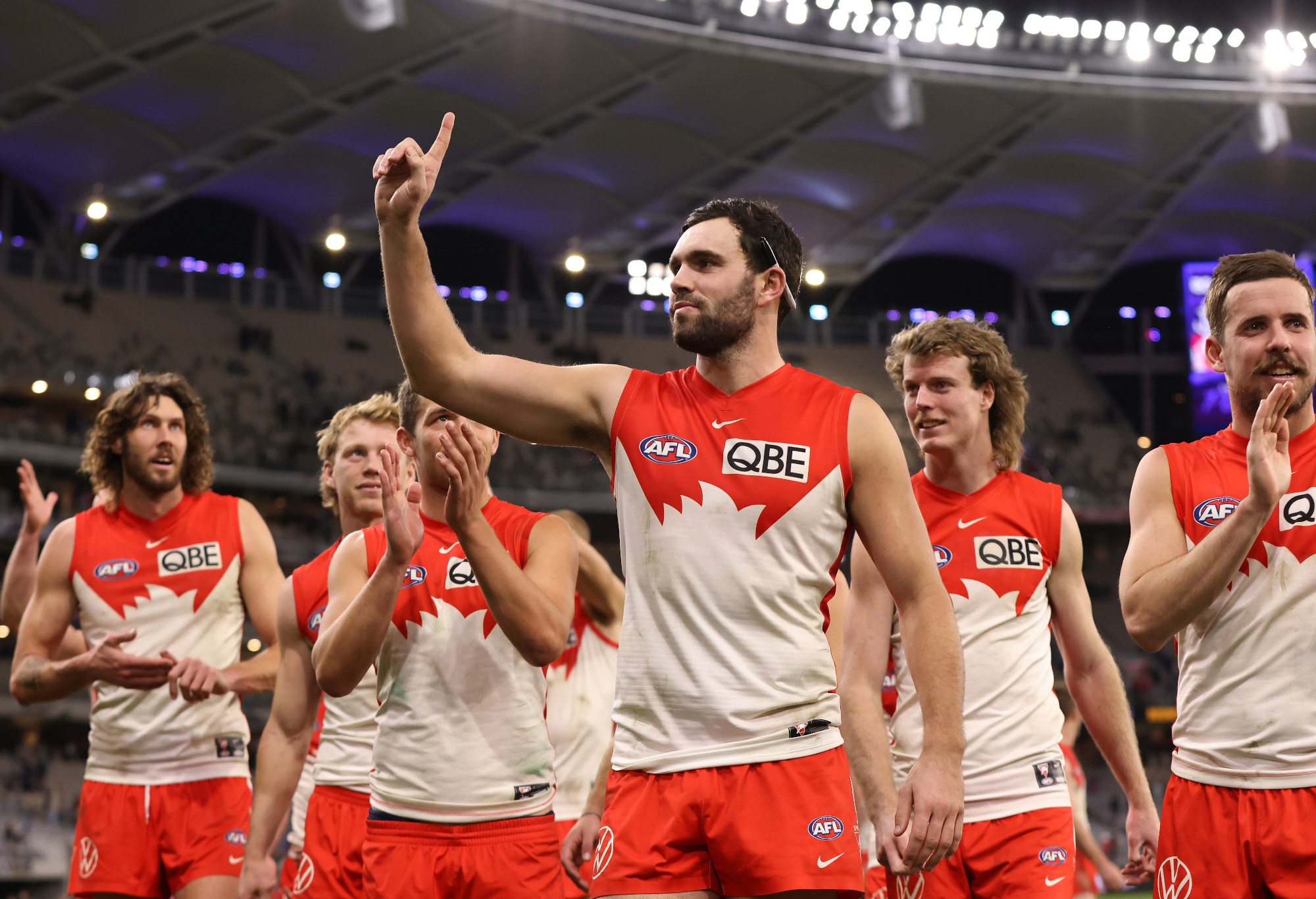
Paddy McCartin. (Photo by Paul Kane/Getty Images)
30. Jonathon Patton (GWS, 2011)
Unfortunately for Patton, his promising career will always be remembered for how it ended: amid accusations he sent several women unsolicited sexual images on social media.
It was the end of an ignominious stint at Hawthorn for the bullocking key forward, who managed just six games for the club after moving from GWS and struggling with injuries and mental health concerns.
At the Giants, Patton defied a pair of early-career knee reconstructions to become one of the most powerful key forwards in the game. He’d boot 38 goals in a breakout 2016 season, including four in the club’s heartbreaking preliminary final loss. He’d follow that up with 45 in 2017, forming a lethal combination with Jeremy Cameron.
However, after a disappointing 2018, Patton would tear the ACL in his ‘good’ left knee, missing the entire 2019 season. He’d request a trade to the Hawks, and the rest, as they say, is history.
29. Andrew Purser (Western Bulldogs, 1982)
The second ever number one draft selection, Purser was among a host of Western Australians recruited by the Bulldogs in the aftermath of a disastrous 1982 season.
Aged 24 at the time, the undersized ruckman instantly became a crucial member of the team, missing just one match in his five seasons at the club. He’d win a best and fairest award in 1984 and was crucial to the Bulldogs’ run to the preliminary final in 1985 – including their first finals win in 24 years.
However, his early retirement at just 28, moving back to Perth to continue his primary career as a stockbroker, sees him fall further down the list than his talent deserved.
28. Jamarra Ugle-Hagan (Western Bulldogs, 2020)
It’s still too early to judge just how good the Bulldogs’ athletic tall will be when he reaches his peak; but if his 2023 season is anything to go by, the 21-year old will be a force to be reckoned with.
Kicking 35 goals and playing every game, only inaccuracy prevented Ugle-Hagan from giving a 50-goal season a real shake; an elite overhead mark, silky-smooth mover and (when not going for the big sticks) exceptionally skilled, you can expect him to move further and further up this list in the years to come.
Can he crack the top five by the end? It’ll be tough, but you wouldn’t put it past him.
27. Cam Rayner (Brisbane, 2017)
Just six years into his career – one of them a write-off due to a knee injury – Rayner has plenty of time to shoot his way up this list.
While he has shown glimpses of the explosive midfielder he was touted as when drafted in 2017, a combination of his own developing fitness and the Lions’ midfield strength has seen him spend most of his career as a forward with stints on the ball – and one quickly aborted stint at half-back to begin 2023.
The most recent season was his best, with Rayner’s qualifying final performance, bagging three goals, the strongest sign yet that comparisons to Dustin Martin made in his draft year could prove accurate.
26. Matt Rowell (Gold Coast, 2019)
An utter contested beast at the age of 22, goodness knows just how powerful the Suns’ resident bull will be when he reaches his peak.
Rowell’s first four games at the start of 2020, in which he racked up three consecutive best-afield efforts, still remain the peak of his career: but while injuries have thus far dulled the explosiveness he showed in his junior days, he has never met a hard ball he didn’t want to win.
Number two pick in his draft, teammate and close friend Noah Anderson might have beaten him to All-Australian squad honours in 2023, but we doubt Rowell will remain on zero nominations for long.
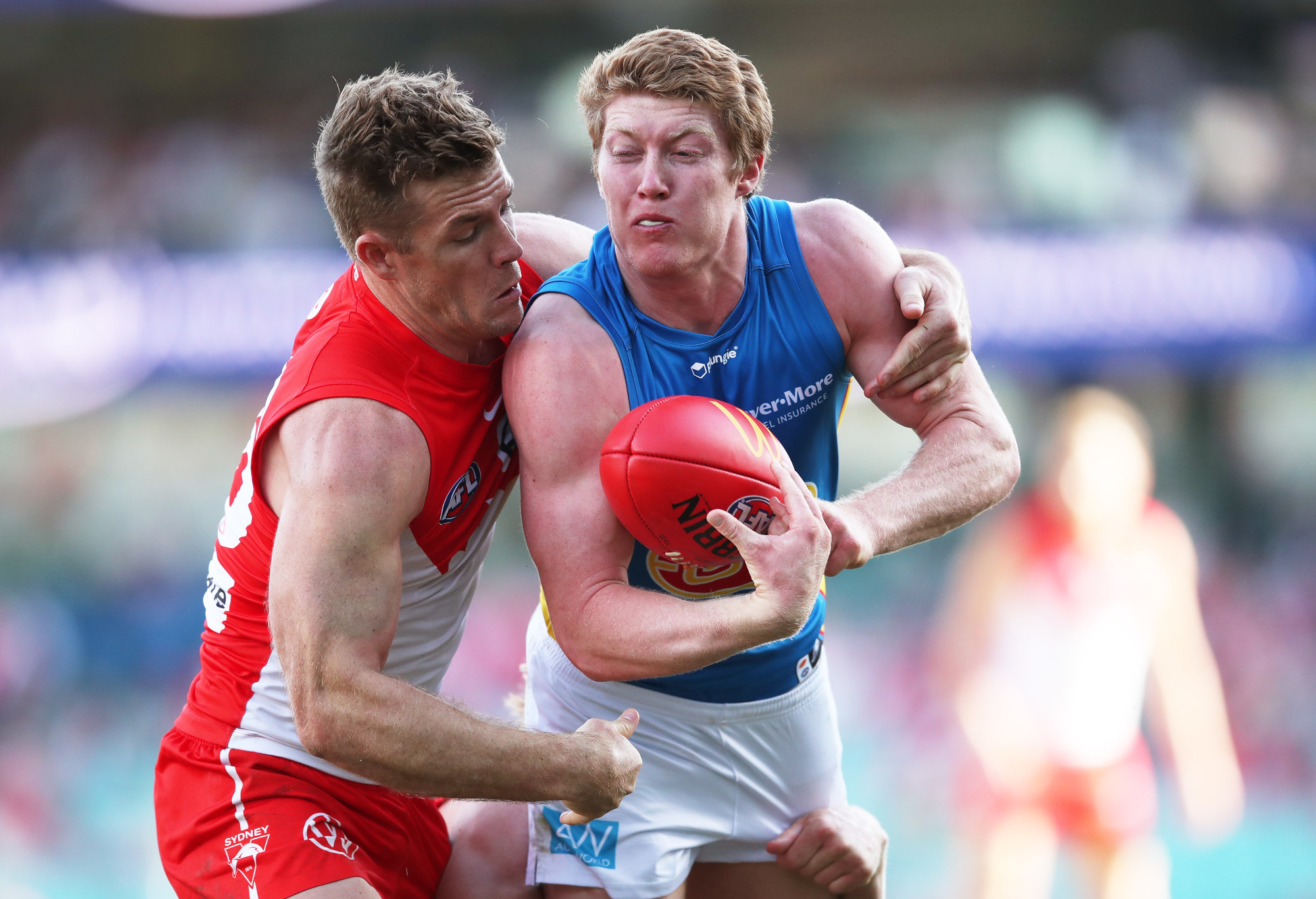
(Photo by Matt King/AFL Photos/via Getty Images)
25. Des Headland (Brisbane, 1998)
An outstanding junior talent who won WA’s best and fairest at the state championships, WAFL team Subiaco’s B&F and the competition’s rising star award, Headland arrived at the Lions in 1999 as the brightest young star in the game.
However, the Western Australian, who was the first Indigenous player to go at pick one, only reached those heights at Brisbane in one glorious purple patch during the 2002 season. In 15 games from Round 11 to the Lions’ premiership win, he’d kick 30 goals and poll 16 Brownlow Medal votes, with three best-on-ground efforts.
Desperate to secure his services, Fremantle moved heaven and earth to bring Headland home. Calf and ankle injuries would hamper him at the Dockers, however, and while he’d add 114 games to his tally, he’d never recapture his 2002 form.
24. Alan Johnson (Melbourne, 1981)
A great of Western Australian football who was inducted into the state’s Hall of Fame in 2017, Johnson was a fine contributor to a strong Melbourne team throughout the late 1980s.
The first number one draft pick, Johnson would win two best and fairests at the Demons in 1983 and 1989. He featured in 135 games, including the 1988 grand final, in which he was one of the Dees’ best players afield in an embarrassing 96-point loss.
Ultimately, having debuted for the Demons at 25, his career was too short to feature any higher up this list.
23. Jack Watts (Melbourne, 2008)
While Watts is indisputably the most maligned number one draft pick in AFL history, playing 174 games at the highest level is a serious accomplishment.
Perhaps the most high-profile victim of Melbourne’s shambolic period in the early 2010s, Watts was never truly able to shake off an inauspicious debut. Thrown to the wolves for the Queen’s Birthday blockbuster despite being unready for the highest level, Watts was mercilessly targeted by Collingwood’s battle-hardened players, and the memory proved permanent.
38 goals in 2016 was a career high, and appeared to have entrenched Watts in the forward line after being tried all around the ground in his formative years. Sadly, Watts’ move to Port Adelaide at the end of 2017 saw him miss the Dees’ return to finals action in 2018 as well as their 2021 premiership; and leaves him eighteenth on the list of most games without a final.
As the poster boy for the Demons’ club-wide failures throughout much of his career, Watts’ name will forever be linked, unfairly, to one of the most shambolic periods in any club’s history.
22. Tom Boyd (GWS, 2013)
Timing is everything in the AFL; and no player proves that more than Tom Boyd. But for one, shining moment, his career haul of 61 games and 50 goals would have landed him even further down this list. But when you win your team a premiership, you get a deserved boost.
An outstanding junior, man mountain Boyd was an obvious choice for GWS’ number one draft pick in 2013. However, he’d last just one year there before being head-hunted by the Western Bulldogs on a multi-million dollar contract, switching places with wantaway Dogs captain Ryan Griffen. Derided at the time, it would prove a decisive moment in the club’s history.
Late-career mental health issues dealing with the pressure his number one pick status and hefty contract placed on him meant he’d retire at 23; but Boyd’s heroics in the Dogs’ fairytale 2016 grand final win will forever see him be part of Whitten Oval folklore.
Kicking three goals and taking a series of towering contested marks, many fans to this day maintain he was the rightful Norm Smith Medallist – and that game alone is the reason why he’s up to 23rd on this list despite his games and goals tallies being significantly lower than some number one picks further down.
His third goal, which all but sealed the premiership, also gave us one of the most iconic moments of sports commentary ever.
21. Jason Horne-Francis (Port Adelaide, 2021)
Yes, he’s played only two seasons – but with 16 Brownlow Medal votes in 2023, the most controversial number one draft pick in recent memory has well and truly hit the ground running in the AFL.
Best afield in his first match for Port Adelaide after acrimoniously departing North Melbourne at the end of 2022, Horne-Francis is already a crucial member of a star-studded Power engine room just 41 games into his career.
Like Ugle-Hagan and Rowell, expect this young gun to only climb further up these rankings with every passing year.
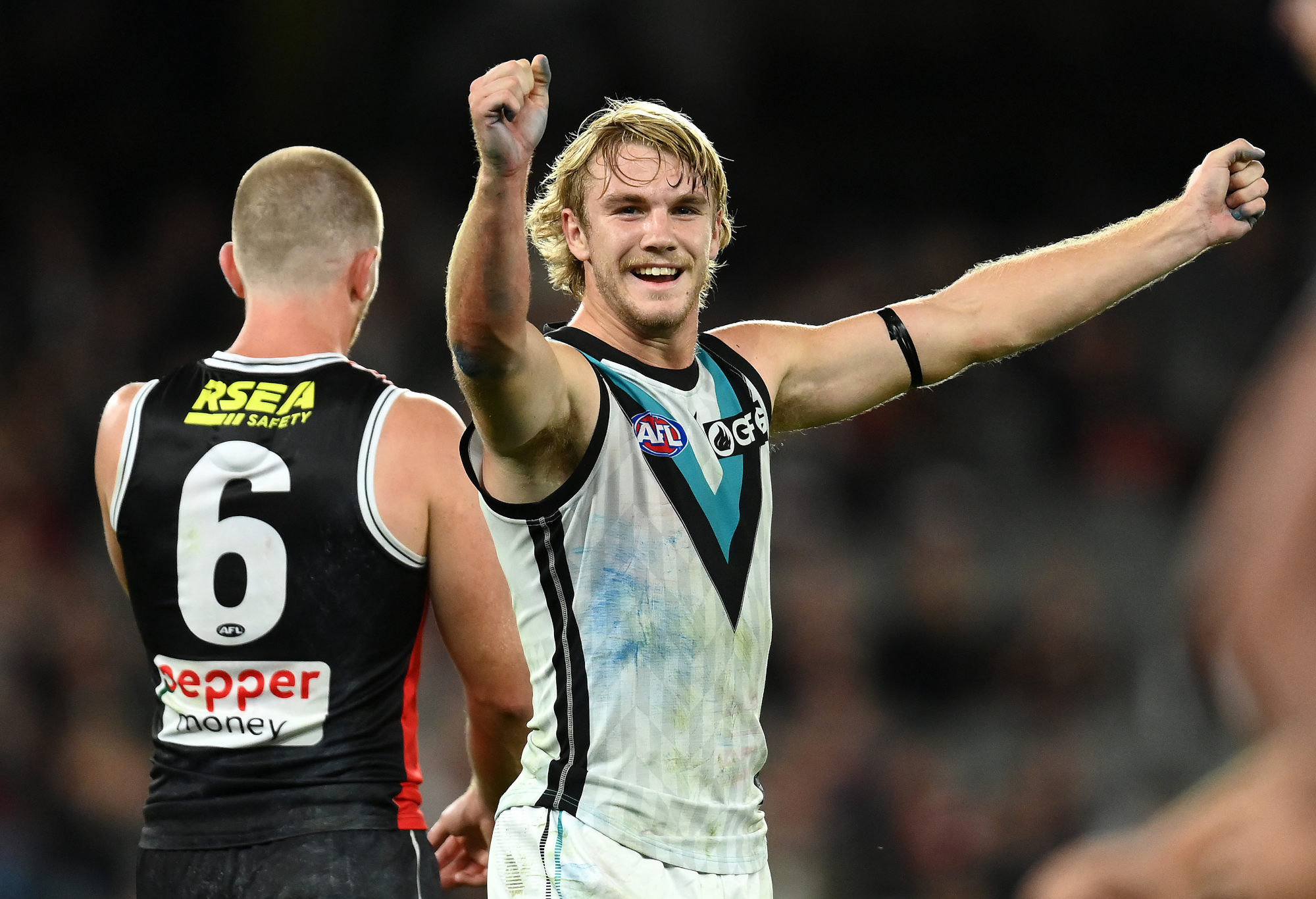
Jason Horne-Francis. (Photo by Quinn Rooney/Getty Images)
20. Tom Scully (Melbourne, 2009)
At his peak, Scully was, if not quite the superstar he was touted as in his junior days, widely regarded as the hardest runner in the AFL. An elite endurance athlete who would regularly play nearly 100 per cent of game time, Scully’s prime years saw him become a crucial cog on the wing in a GWS team that seemed destined for greatness.
Having shown signs of his undoubted talent in his first two seasons at Melbourne, who snapped him and Jack Trengove up with the first two picks of the 2009 draft, Scully became the most high-profile signing by new expansion side the Giants leading into 2012. On a six year, $6 million contract, he turned his back on the Dees and headed north.
However, he’d never be named in an All Australian team, nor win a club best and fairest; a disappointing return for one of the most hyped juniors in draft history. Scully finished up quietly with two years at Hawthorn after the Giants discarded him, believing persistent ankle injuries to have all but ended his career.
19. Matthew Kreuzer (Carlton, 2007)
Such was the hype around Kreuzer heading into the 2007 draft that in Round 22 of that season, Melbourne and Carlton played a match known as the ‘Kreuzer Cup’. If Carlton lost, they would finish last and earn the right to take the ruckman with the number one draft pick. They lost.
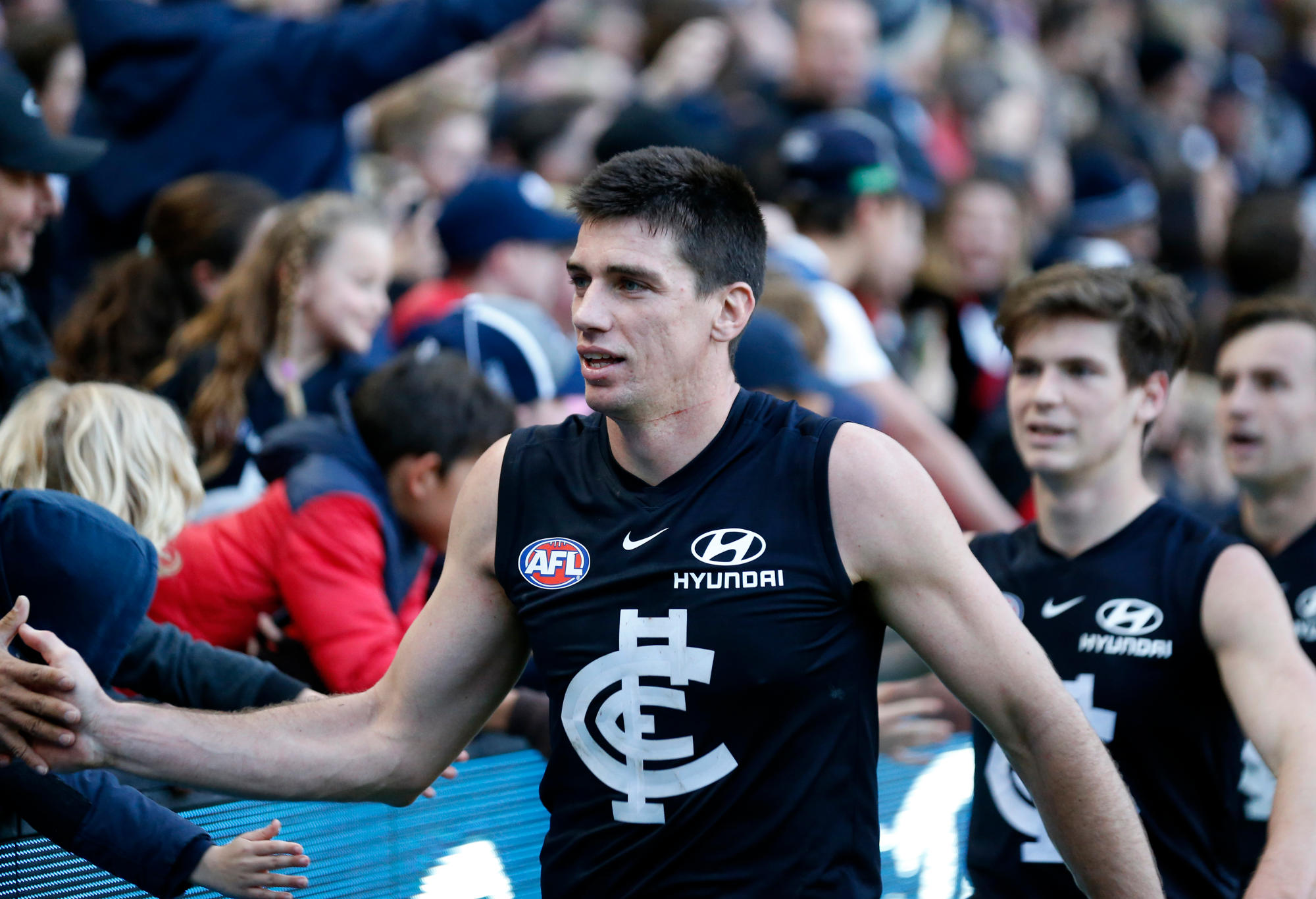
(Photo by Darrian Traynor/Getty Images)
Unfortunately, injuries prevented Kreuzer from ever reaching his full potential, though he’d finish with a more than creditable 189 games. After debuting in Round 3 of 2008, 56 of them came consecutively, but a ruptured ACL midway through 2010 would prove a portent of things to come.
After years plagued by numerous injuries, the ruckman would enjoy a career-best 2017 season, missing just one and being named in the All Australian squad. After that, however, normal service would resume. His final game, injured midway through the Blues’ Round 1, 2020 match against Richmond, was an unfortunate if fitting way to bow out.
18. Andrew McGrath (Essendon, 2016)
Touted as a future Bombers captain, McGrath was taken by the Bombers with the number one pick following their first-ever wooden spoon, caused by the suspension of half their playing list due to the infamous supplements scandal. Winning the AFL Rising Star award in his debut season, it quickly proved a shrewd selection.
While always touted as a future midfield star, McGrath’s best footy has thus far been played as a half-back, and that is set to be his primary role under Brad Scott. Capable of shutting down dangerous small forwards and providing rebound, the 25-year old probably hasn’t quite kicked on as many thought he would after 2017 – but he still has ample time.
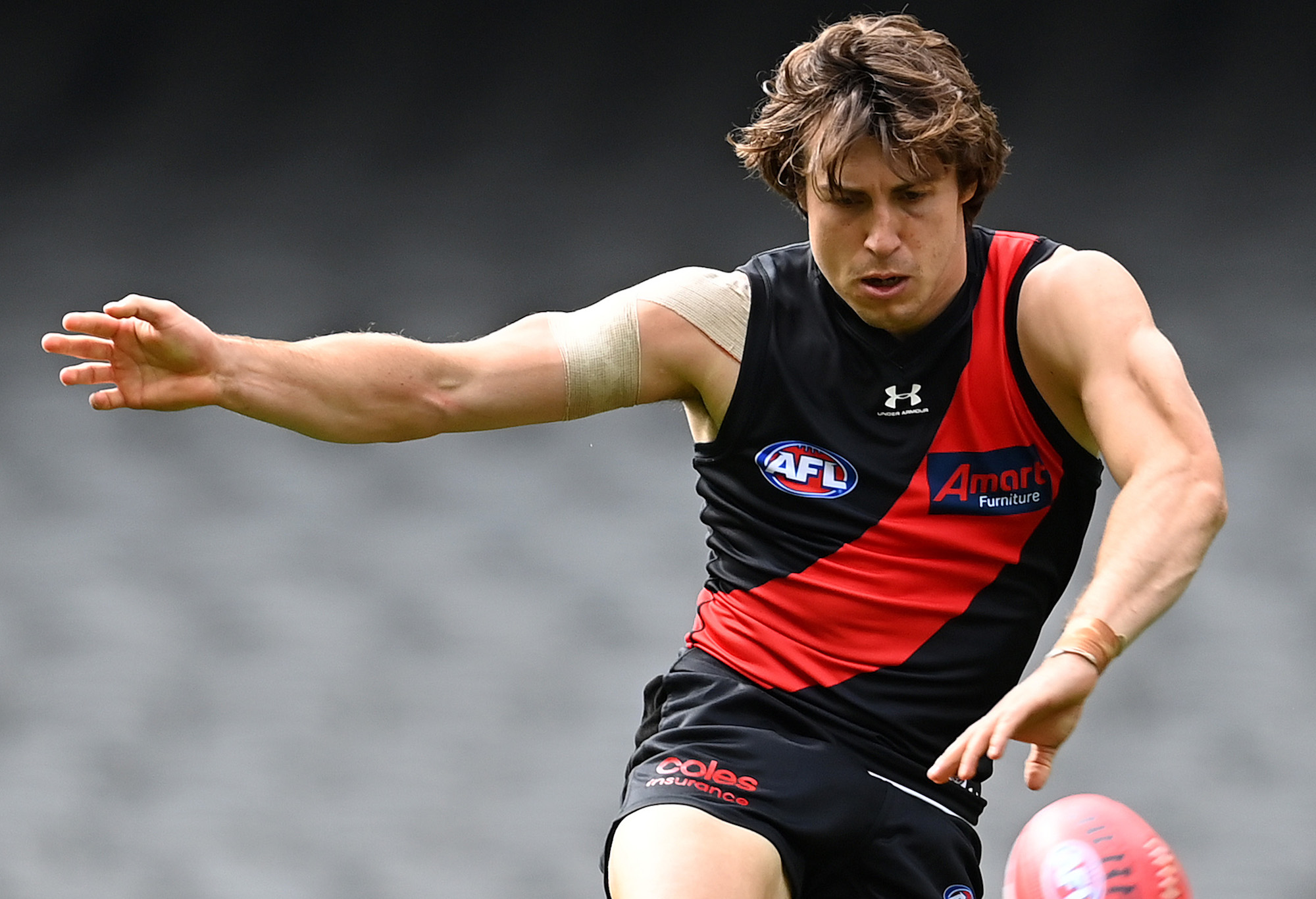
Andrew McGrath (Photo by Quinn Rooney/Getty Images)
17. David Swallow (Gold Coast, 2010)
That Swallow has only featured in 64 wins in 220 career games encapsulates the Suns’ ugly history in a nutshell. As co-captain of the club, however, Swallow is one of the few draftees from the club’s formative years to have stuck with them through thick and thin… mostly thin.
An outstanding junior, the Suns were so sure they would be taking him with pick one of their inaugural draft that they received permission from the AFL to play for the club in their one-year stint in the VFL before joining the AFL. A member of their first-ever 22, he’d miss just one match in his debut season.
A career-best year came in 2014, still Gold Coast’s best ever year, when he became just the second Sun after Gary Ablett to win the club’s best and fairest award – helped by Ablett missing the final seven games through injury. Aside from 2015, he has seldom missed games through injury, but has been unable to turn around the club’s fortunes in the way Ablett briefly was.
Nevertheless, Swallow’s career would be regarded much more highly had he followed teammates Steven May, Tom Lynch and plenty of others in deserting the club.
16. Travis Johnstone (Melbourne, 1997)
Troubled by inconsistency, Johnstone’s best football was well and truly worthy of a number one pick.
After an inauspicious first few years at the Demons, despite being picked for their 2000 grand final loss to Essendon, the hard-nosed midfielder broke out in 2002. Finishing fourth in the Brownlow Medal with 16 votes, culminating in a 25-disposal, four-goal haul in a narrow semi-final defeat, Johnstone had arrived on the biggest stage.
He’d go on to win a best and fairest in 2005, but it was one of only two top-ten finishes in the award in ten years at the club, epitomising his lack of consistency. He’d finish his career at Brisbane as the Dees, under new coach Dean Bailey, looked to stockpile draft picks, adding 49 more appearances to reach the 200-game milestone.
15. Darren Gaspar (Sydney, 1993)
Sometimes all you need is a second chance; so it was with Gaspar. After two years and 21 games with Sydney after being taken with pick one, the defender decided to head to Richmond, lured by then-coach Robert Walls. It would prove a wise choice for both.
A reliable stopper for a decade with Richmond, Gaspar made his name curtailing some of the AFL’s best forwards. He’d win a club best and fairest in a preliminary final year in 2001, while being named in the backline of the All Australian team for the second straight year.
With 228 games, 207 with the Tigers, the much-loved Gaspar was as reliable as they come.
14. Drew Banfield (West Coast, 1992)
A dual premiership winner with the Eagles, Banfield bowed out in 2006 with the second-most games in club history. Despite being a pivotal member of the team’s backline from the outset, his selflessness would ultimately prevent him from truly being regarded among the game’s greats.
However, a best and fairest in 1996 signified his undoubted talent, and his 265 games remains among the most by any number one draft pick.
13. Michael Gardiner (West Coast, 1996)
A strong ruckman-forward, Gardiner’s best was simply sublime. An All Australian in 2003, he was the prototype of the modern ruckman, with his mobility and agility for his size a world away from the dinosaurs of the 1980s.
After that, though, knee injuries would restrict him; by the time he returned to regular senior football midway through 2005, Dean Cox had usurped him as the Eagles’, and the AFL’s, premier ruckman.
He’d last two further years at the club before off-field issues, many of them with friend Ben Cousins, saw him axed by the Eagles at the end of 2006. He’d move to St Kilda, where he’d play 52 more games including grand finals in 2009 and 2010. The finest moment of his career arguably also came at the Saints, when his four-goal, best-afield performance in 2009 against Geelong helped win one of the greatest matches in AFL history.
12. Josh Fraser (Collingwood, 1999)
At the time of his draft, Fraser was the most hyped number one pick yet. An outstanding junior ruckman, the country Victoria product was snaffled by the Magpies with their to date only top selection, and instantly became the club’s first-choice ruck.
A goalkicking big man, Fraser booted 37 goals in 2002, including three in the Pies’ heartbreaking grand final loss to Brisbane to be one of the best afield. Another impressive year followed in 2003, and it seemed the sky was the limit.
However, Fraser’s mobility and speed caused a weakness: his relatively light frame prevented him from becoming a truly dominant ruckman. By 2010, the Pies opted to recruit the more imposing Darren Jolly from Sydney, who quickly usurped the veteran as the number one ruck, leading the club to a premiership. He’d end with two largely forgettable years at the newly formed Gold Coast.
11. Bryce Gibbs (Carlton, 2006)
The second of three consecutive top picks for the Blues in the mid-2000s, Gibbs was a dominant force in his draft year against grown men in the SANFL. An obvious pick one, he played ever game in his debut season of 2007 and never looked back.
Remarkably, only once at the Blues – in 2015 – did Gibbs fail to play 20 games in a season, with his durability eventually leading to a best and fairest in 2014. However, he’d never make an All Australian team, which causes him to narrowly miss the top 10 of this list.
He’d finish his career back home in South Australia for Adelaide, though he’d only manage 37 games as the club opted for youth. However, he’d finish his career with a 27-disposal effort in an upset Crows win over former side the Blues in late 2020, before winning the SANFL’s Margarey Medal in 2021.
10. Jeff White (Fremantle, 1994)
While he was drafted by the Dockers, it was at Melbourne where White made his name. A mobile ruckman who, at 195cm, was one of the shortest big men in the game, his elite athleticism and outstanding vertical leap saw him defy his height to be one of the game’s best big men at his peak.
Winning a best and fairest and All Australian selection in 2004 were highlights of White’s 268-game career; as was his nerveless winning goal in a crucial late-season match against the Western Bulldogs a year later, which ultimately saw Melbourne sneak into the finals.
He’d finish in 2008 as the Demons opted for youth, but his spot in the club’s history was already well and truly secure.
9. Lachie Whitfield (GWS, 2012)
One of the best kicks in the AFL and an elite runner, there are few players more important at the Giants than star winger Whitfield. Having signed a whopping seven-year deal that ties him to the club until the end of 2027, he’s not going anywhere anytime soon, either.
While an undoubted talent in the Giants’ foundational years, it took until 2018 for Whitfield to be recognised as among the AFL’s elite. Named at half-back in the All Australian team and winning the club’s best and fairest, he had arrived.
Since then, he has been a key cog in one of the competition’s most talented teams, defying a horror 2020 for the club to win the best and fairest award and remaining one of the Giants’ most elite outside runners through to the present day.
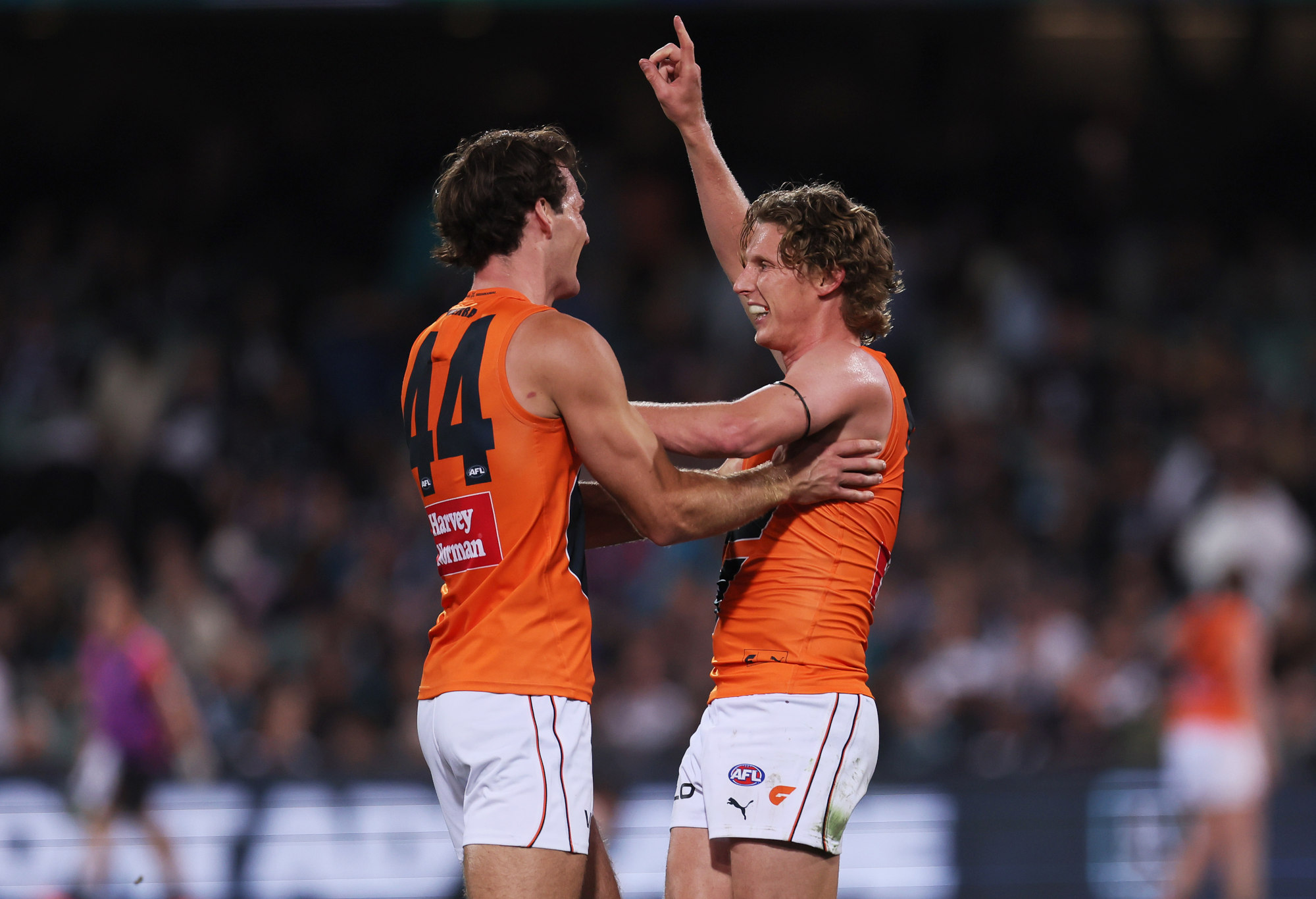
Jack Buckley and Lachie Whitfield celebrate the Giants’ 2023 semi final win over Port Adelaide. (Photo by James Elsby/AFL Photos via Getty Images)
8. Adam Cooney (Western Bulldogs, 2003)
Groin injuries in the last eight years of his career left him barely able to train, but before then, the red-headed midfielder was unquestionably one of the AFL’s finest.
A surprise Brownlow Medallist in 2008 to lead the Bulldogs to a preliminary final, Cooney excelled with his elite speed, penetrating kicking and goal nous. In his Brownlow year, he’d average nearly a goal per game while averaging north of 25 disposals. While he’d be nearly as good again in 2009, that’s when injuries started to bite.
He’d finish his career with two years at Essendon, where he’d provide much-needed experience to a club reeling from the supplements scandal. He remains the only pick one with a Brownlow to his name.
7. Jacob Weitering (Carlton, 2015)
One of the AFL’s best key defenders, Weitering took a while to find his feet in the AFL, but his last few seasons have proved worth the wait.
Winning best and fairests in 2020 and 2023, the 25-year old (he will be 26 on November 23) is still somehow yet to be named in an All-Australian team despite four consecutive years in the squad, but he would rank up with Charlie Curnow as the Blues’ most important player.
Weitering will be a cornerstone for the Blues to build around in the years to come, and more honours in the future appear almost a formality.
6. Marc Murphy (Carlton, 2005)
Fittingly, the Blues allowed Murphy to join the AFL’s prestigious 300-game club in 2021, despite being well past his best. It was an appropriate award for a player who had led the club admirably through plenty of ups and downs.
Tied to Brisbane as a father-son option, Murphy chose to nominate for the draft instead, being quickly snapped up by the Blues. It took him little time to find his feet, finishing second to a Chris Judd at the peak of his powers in the club best and fairest in 2008.
His maiden best and fairest, the AFL Coaches Association’s pick for player of the year, and All Australian honours, were to follow in 2011, as Murphy powered the Blues to their first finals win in a decade. He’d add a second club champion award in 2017, albeit in a far lesser outfit.
Finishing with 300 games, Murphy bows out as a great of both club and sport.
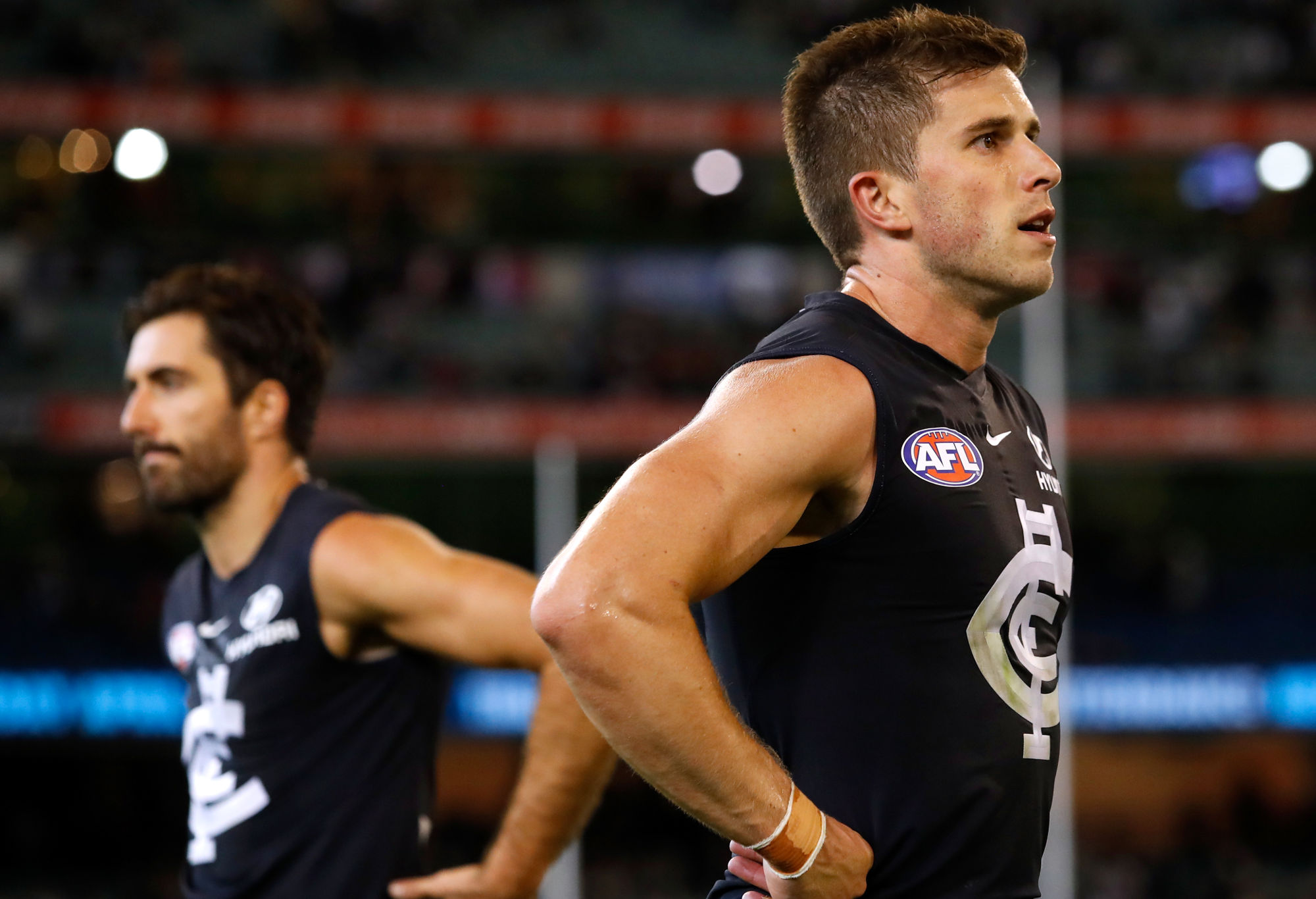
(Photo by Adam Trafford/AFL Media/Getty Images)
5. Brett Deledio (Richmond, 2004)
One of the most tragic AFL stories of recent years, Deledio was a star for the Tigers during a period of frustration and misfortune… only to finally look for options elsewhere just as the club was poised to break its 37-year premiership drought.
Drafted with the Tigers’ top pick in 2004, Deledio became one of the few pick ones to win that year’s Rising Star award, after an outstanding debut campaign. He’d seldom look back from there, winning back-to-back best and fairests in 2008 and 2009, and being named an All Australian in 2012 and 2015. Hard-working, elite by foot and capable of playing in any position you’d care to name, his importance to the team was epitomised in 2014 and 2015; the Tigers would only win two of the nine games he missed.
After 243 exceptional games for the club, a 29-year old Deledio chose to head to GWS in 2016, hoping to secure a long-elusive premiership, or even a maiden finals win. However, the move would end in heartbreak, the Tigers rising from nowhere to claim the 2017 premiership, along the way knocking out Deledio’s Giants in the preliminary final.
4. Brendon Goddard (St Kilda, 2002)
But for Carlton’s salary cap scandal in his draft year, Goddard would have started his career as a Blue. It would prove a turning point in Saints’ history that he was available for their top pick, with the Blues stripped of theirs.
Starting as a half-back, Goddard would blossom to become one of the AFL’s most powerful midfielders. With a booming kick, elite footy smarts and courage to spare, it was remarkable he’d never win a best and fairest award, even in a dominant Saints team.
An All Australian in 2009 and 2010, it’s unsurprising his best footy coincided with the Saints’ twin grand final appearances. In the famous 2010 drawn decider, Goddard was close to best afield, finishing second in the Norm Smith Medal voting and taking one of the most iconic marks in grand final history.
Goddard would leave the Saints to head to Essendon, hoping for more success; instead, he walked into a club on the verge of crisis. Just months after joining, the infamous supplements scandal broke, derailing the club for almost the rest of his career.
He’d win a best and fairest in his first season at the club, 2013, and captain the Dons during their darkest hour of 2016. While he wasn’t always able to keep his temper in check…
… Goddard’s 334 career games makes him unquestionably one of the modern era’s greats.
We’re not sure those pretzels would agree, though.
3. Sam Walsh (Carlton, 2018)
Just five years into his AFL career, Walsh is reaching heights few 21-year olds have ever attained in the game.
An All Australian selection, club best and fairest and a whopping 30 Brownlow Medal votes – the youngest player ever to reach that figure – in 2021 alone, Walsh’s rise into the elite of the AFL has been as rapid as it has been completely expected.
An exceptional junior, few number one draft picks have been as highly touted as Walsh. Since then, his durability, ball-winning skills and elite endurance have seen him continue to rise into the game’s true elite, even if injuries have slightly stagnated his progress in recent seasons – and considering he won the 2019 AFL Rising Star award in a landslide, that’s a serious effort.
Now that the Blues are emerging as a premiership contender, expect Walsh’s star to only continue to rise in the years to come.
2. Luke Hodge (Hawthorn, 2001)
The top two number one draft picks in history are just about unsplittable, and both are undoubted future Hall of Fame inductees (and probably Legends, too). But in a line-ball decision, it is Hawthorn champion Hodge who is relegated to second fiddle.
But that shouldn’t detract from one of the finest careers in AFL history. After the Hawks traded out a pair of young stars in Trent Croad and Luke McPharlin for Fremantle’s prized number one pick in the infamous 2001 ‘Superdraft’, there was pressure on Hodge from the outset. He’d prove more than capable of withstanding it.
An All Australian by 21, a best and fairest winner the same year and a Norm Smith Medallist by 24, Hodge’s career had as many accolades as many of the game’s greats by the halfway mark. But while the individual honours wouldn’t quite fly so thick and fast thereafter, his greatest impact was yet to come.
Finally fulfilling his destiny as Hawks captain in 2011, Hodge would become one of the best leaders in AFL history. As inspirational as they come – his 2008 Norm Smith performance was carried out with a rib injury that he still to this day refuses to reveal the extent of – and an expert marshal of his troops off either half-back or in midfield, Hodge was the conductor in the Hawks’ almighty orchestra during the early 2010s.
He and his team would secure their place in footy folklore with three consecutive premierships from 2013-15; in the middle one, described as their ‘masterpiece’ by commentator Bruce McAvaney, Hodge became just the second player to win a second Norm Smith Medal.
After announcing his retirement at the end of 2017, Hodge shocked the footy world by reneging on that and heading to Brisbane for the 2018 season. His leadership and footy brain were as crucial as anything to the Lions’ remarkable rise to second on the ladder in 2019. Bowing out with a semi-final loss that year, Hodge ended as one of the most influential players in the history of the AFL – and one of the most decorated.
1. Nick Riewoldt (St Kilda, 2000)
Before we get into the nuts and bolts of Riewoldt’s decorated career, make sure you watch this again.
This one mark, inexplicably not awarded the 2004 Mark of the Year award, epitomises Riewoldt perfectly. Incredible athleticism, insane courage, and freakish skill… and yet the top prize eluded him.
Had Riewoldt secured a premiership with St Kilda – and he came agonisingly close in both 2009 and 2010 – his place at the top of this list would be a formality. Instead, he takes out the top gong by a whisker over the more successful Hodge.
Enough of that, though: let’s talk Riewoldt the footballer. A rising star winner in his second season of 2002 after developing in 2001, the blonde number 12 led the AFL for marks after the home-and-away season. He’d go on to do that quite a bit.
At just 21, he was named to his first All Australian team in 2004 – the year of his legendary mark – booting 67 goals for the season as the Saints suffered preliminary final heartbreak. Another 60-goal season was to come in 2006; but it was the arrival of Ross Lyon as coach in 2007 that saw Riewoldt take the final step from gun to champion.
Captaining the side to an unprecedented level of success, Riewoldt was named at centre-half forward in back-to-back All Australian teams in 2008 and 2009, the latter as captain. Injuries prevented him from doing likewise in 2010, but he’d return for a fifth selection in 2014, a decade after his first, this time in a team which won the wooden spoon.
Currently sitting third for most games as captain in AFL history with 220, Riewoldt reached the 300-game milestone in 2016. By then, he was past the peak of his powers but remained one of the best in the game; with an equal career-high nine goals in Round 23 against Brisbane, he proved he was far from a spent force.
Undisputably the hardest runner in the game’s history, virtually ever modern defender rates Riewoldt as the hardest player they’ve ever come up against: there can be no higher praise. After 336 games, he retired at the end of 2017 as arguably St Kilda’s greatest ever player, a legend of the game… but without the premiership medal that would have cemented him as an AFL immortal.
Agree with our list? Who’s your pick for the greatest number one draft pick in VFL/AFL history?
With Harley Reid (or maaaaybe someone else?) set to join the ranks on Wednesday night, be sure to tune in to The Roar’s live coverage of the 2023 AFL draft, for every pick as it happens.